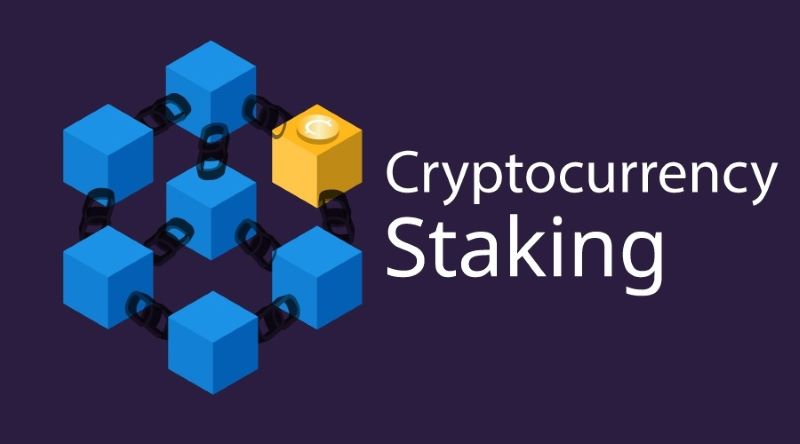Dive into the digital tide and unlock the power to grow your coins. What is stacking in crypto? It’s not just buying and holding; it’s your ticket to earning more, actively. I’ll guide you through this clever trick in the crypto playbook. No jargon, no fluff – just the juicy stuff you need to boost your crypto game. Ready to stack up your assets? Let’s peel back the layers of this crypto conundrum and get your digital wallet working overtime.
Unraveling Cryptocurrency Staking: The Basics
What is Crypto Staking?
Have you ever wondered what staking in crypto means? It’s like earning interest. By holding certain digital currencies, you can earn extra coins. This process is known as staking.
Imagine you have a piggy bank, but this one is smart. You put crypto coins into it, and over time, it fills up even more on its own. That’s crypto staking for you. You stack your digital coins to support the coin’s network and, in return, get rewards.
Understanding Proof of Stake (POS) and its Mechanism
Proof of stake, or POS, is a way a coin’s network makes sure all transactions are true and safe. Each person staking coins is helping to do this big job. Think of it as a raffle. The more coins you stack, the more chances to win the job of checking transactions and getting rewards.
But, it’s not just about stacking tokens for rewards. It’s about being part of the network. When you stake coins, you’re like a mini-bank, helping make everything run smoothly. And for doing this, you get paid with more coins. It’s your passive income from crypto.
Some coins let anyone stake, while others have staking pools in blockchain. A staking pool lets a bunch of people put their coins together. This makes them have a better chance at earning those staking rewards.
Don’t forget, the rewards you earn are a part of the annual percentage yield (APY) in staking. APY tells you how much you can earn in a year with your staked coins. The best staking coins will give you a high APY. But high returns can come with high risks of staking crypto.
So, when you think about how to stake digital currencies, keep in mind a few things. Choose a staking platform with care, know the risks, and look for good rewards.
In POS crypto, there’s another key player called validator nodes. These are the heavy lifters, doing the hard work of making sure all transactions are OK. If you stake a lot, you can become one. But being a validator takes a lot of responsibility.
One last thing, remember that staking coins sometimes means you can’t use them for a while. This is called a lockup period. But once it’s over, you can take your coins out if you want. This process is known as unstaking crypto assets.
So that’s the starter pack on crypto staking. It’s about helping the coin’s community, keeping the network secure, and yes, earning some sweet, sweet passive income. It shows you’re not just here for the ride; you’re also driving the car along with others. And hey, who doesn’t like a bit of extra coin in their virtual pocket, right?
Maximizing Your Earnings: Staking Rewards and APY
How to Calculate Potential Staking Returns
To max out what you make in staking, know your potential returns. Start with the APY. This is the rate of money you earn, shown as a yearly percent. It’s like how your savings account gives you interest. In crypto, APY shows what you could make from staking over a year.
Always add up your coins and APY to get started. Let’s say you have 100 coins with a 5% APY. Your math would look like this: 100 coins times 0.05 (which is 5% as a decimal) equals 5 coins. So, in a year, you’d earn 5 extra coins for staking 100.
Remember, APY can change. Rates jump up and down based on the market and the coin’s rules.
Selecting the Best Staking Coins for Optimal APY
When you pick coins to stake, look for the best APY. But don’t stop there. Always read up on the coin and its track record. Ask yourself:
- Does this coin look strong for the long run?
- What do others say about it?
- What’s the deal with its lockup period?
A lockup period is when you can’t take out your coins. Think of it as a time out. The coin stays put and earns for you. But there’s a catch: you must leave it alone for a while. This can change how you feel about your pick.
Then, size up the risks. Every coin has them. Knowing the risks means no bad surprises later.
A good way to stake is through a pool. This is like joining a group. You all add your coins together. Doing this can up your chances to get rewards.
So, here’s what makes a top pick for staking:
- High APY
- Strong coin with a good history
- A lockup period that works for you
- Risks you’re cool with
Always keep in mind, crypto can be wild. Prices swing a lot. Even the best coins might dive in value. When you stake, you lock in for a while. If the price dives, you might not be able to sell right away.
To wrap things up, staking lets you make passive income. You just lock your coins and earn. High APY makes the best choice. Know the risks and how it all works before you jump in. That’s how you bank the most from staking.
Staking smart needs you to do your homework and stay on top of things. But get it right, and you could see your crypto stash grow without doing much at all. Choose wisely, stake safely, and keep an eye on that APY!
Participating in the Staking Ecosystem
The Role of Validator Nodes and Network Participation
Let’s get to the heart of staking in crypto. When you hear “staking,” think of earning rewards by helping a crypto network run smoothly. Validator nodes are like the system’s watchful guardians. They check and add new blocks of transactions to the blockchain. But here’s the catch: to become a validator node, you need to stake your own coins.
Imagine a big pot of soup everyone’s cooking together. By adding some of your veggies (aka your coins) to the pot, you’re saying, “I’ll help watch it.” Do a good job, and you get a bigger bowl of soup back as extra rewards—these are your staking rewards. Miss a step, and a bit of your veggies might be taken away or your bowl shrinks. This is how the crypto network ensures everyone does their part.
If you want to join this kitchen but can’t spare many veggies, no worries! You enter what’s known as a staking pool. That’s a group of folks who combine their resources to become a validator node. Everyone shares the work and the tasty soup afterwards.
Exploring Staking Pools and Delegated Proof of Stake Models
Some staking means you need to wait a bit to get your veggies back. That’s the lockup period. The time varies a lot depending on the crypto type.
But what if you’re not one for waiting? That’s where the cool kids, delegated proof of stake (DPoS), step in. It’s like staking with a twist. You vote for other nodes to watch the pot for you. You still get a share of the soup without minding the pot all the time. This is great if you’d rather not deal with the techy stuff.
Choosing the right pool or model is a bit like picking a cooking class. Look at the chef’s (validator’s) record, the type of soup (crypto), and the class size (pool size). Smaller might mean more soup per person, but big can mean many chefs making sure nothing burns.
The recipe might promise a certain APY – that’s like your soup bigger-up. But, watch out! Too many chefs can eat into your rewards, and there are always risks in the kitchen. Say, the crypto market can get shaky, or the pool’s recipe isn’t that great. Risks matter, so keep an eye out.
Staking’s a fun way to have your crypto make more crypto while backing the network. With a good pick, you can scoop up some nice crypto soup – I mean, rewards. Just remember all kitchens have rules, and know what you’re walking into. Happy staking!
Navigating the Complexities of Crypto Staking
Risks and Considerations in Staking Digital Currencies
Staking is a way to earn rewards with your crypto. You lock coins and get new coins in return. Like a savings account, but for digital money. Not all coins can be staked, only the ones that use a system called proof of stake. This system helps keep the coin’s network safe and working well.
Staking has risks, just like anything else in crypto. You could lose money if the coin’s value drops. Sometimes, there are rules about how long you must stake your coins. Breaking these rules can result in a penalty. Plus, don’t forget the tech risk. If the staking platform has problems, your coins could be at risk too.
Be smart about where you stake. Use trusted platforms and wallets. Keep an eye on the market. The coin’s price can affect your staking rewards big time.
Liquid vs. Cold Staking: Understanding Your Options
You’ve got two main choices in staking: liquid and cold. Liquid staking means you can still use your coins while they earn rewards. You’re not stuck; you can trade if you want to. It’s flexible but often gives smaller rewards.
Cold staking is more like a lockbox. You can’t touch your coins for a set time. This can be safer and may give you bigger rewards. But remember, you won’t be able to sell or move those coins until the time is up.
Choosing between liquid and cold staking depends on what you want. Do you need quick access to your coins, or can you wait longer for possibly bigger returns? Think about your goals and choose wisely.
Each choice has pros and cons. More freedom or higher rewards? That’s the trade-off. Check out both options and see what fits your style best.
Always remember, staking is a commitment. Whether it’s hot and easy to move like liquid or locked up tight like cold, pick the path that matches your crypto journey.
In this post, we dug into the nuts and bolts of cryptocurrency staking. From what it’s all about, to how earnings work, we covered it all. We looked at the Proof of Stake method and talked about how you can figure out your possible returns. Choosing the top coins for staking can make your APY better.
We also explained how you can be part of staking by becoming a validator or joining a pool. Know that staking’s not without risks, and you’ve got to choose between liquid and cold staking.
My final thoughts? Staking is a smart way to earn from your crypto, but you need to pick wisely and understand what you’re getting into. Play it safe, do your homework, and staking could be a solid move for your digital coins. Stay sharp and you might just see your crypto stack grow.
Q&A :
What Exactly Is Stacking in the Crypto Context?
Stacking in crypto refers to the process of actively participating in blockchain operations by holding and locking away a certain number of cryptocurrency tokens, with the intention of supporting the overall network infrastructure. This approach usually helps in validating transactions or achieving consensus and is often rewarded with additional cryptocurrency tokens as a form of passive income.
How Does Crypto Stacking Contribute to a Blockchain Network?
Crypto stacking is instrumental in blockchain networks that use Proof of Stake (PoS) or related consensus mechanisms. By stacking their tokens, users can contribute to the network’s security and efficiency. Participants, often called validators or stakers, help to maintain the integrity of the blockchain by ensuring that all transactions are verified and recorded accurately and in a trustless manner.
Are There Risks Involved with Stacking Crypto?
Like most crypto-related activities, stacking is not devoid of risks. One primary risk is the volatility of the cryptocurrency market, which can affect the value of the staked tokens. Additionally, there’s the risk of staking in a network that gets attacked or compromised, which could potentially lead to a loss of staked assets. It’s crucial to perform due diligence on the blockchain platform and its security before engaging in stacking.
Can I Stack Any Type of Cryptocurrency?
Not all cryptocurrencies can be stacked. Stacking is specific to certain cryptocurrencies that use the Proof of Stake (PoS) model or variations of it, such as Delegated Proof of Stake (DPoS) or Leased Proof of Stake (LPoS). Examples of stackable cryptocurrencies include Ethereum (after its 2.0 upgrade), Cardano, and Tezos.
What Are the Benefits of Stacking Cryptocurrencies?
Stacking cryptocurrencies offers several benefits including the potential for earning interest on staked holdings, contributing to the security and governance of the blockchain, and having a say in the future directions of the network through voting rights. It’s a way to get involved with the blockchain community and potentially earn rewards without needing to invest in expensive mining equipment.





